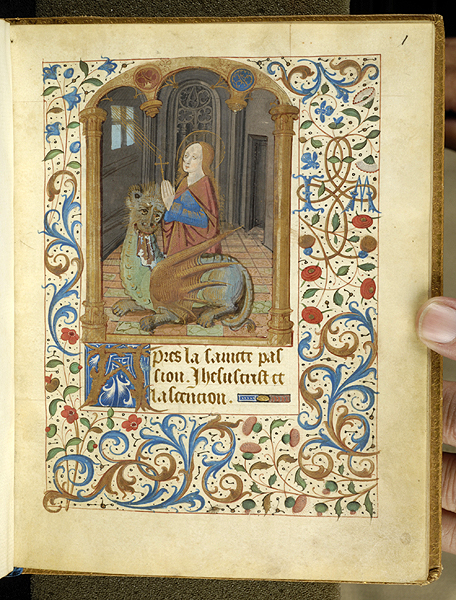

For this purpose, a parchment sheet was placed around the book block and the stitching threads were strung through the looped back, which was often reinforced with horn plates. They mostly carried flexible envelopes, the so-called limp vellum binding (Kopert). Since wooden book covers made transport more difficult, lighter materials were used already in the Middle Ages for books which should be easily transportable, such as those for students and preachers. Many books are only decorated with artfully designed covers but also with richly decorated and gilded edges (.28, Ph.o.483, Th.dp.o.117g, RB.Th.mor.o.6, Bibl. Special skills on the part of the bookbinder as well as the reader were required for a book that could be opened from six different sides, a so-called vexation binding (L.th.c.q.5). 154) as well as silver covers (RB.Th.lit.d.33-m, Sel.365) are other impressive highlights of the Bamberg collection. The Bipontina room, a showroom in the State Library, still recreates the original display of a part of the Zweibrücken library.īindings decorated with painted portraits of Saxon electors (Bibl.q.76, L.gr.o.307a), coats of arms for patricians (JH.Ma.q.3) and cardinals (JH.Bg.o. This collection also contains numerous examples of French art of bookbinding. The back cover is decorated with the coat of arms of the cathedral dean Erasmus Neustetter and the cathedral capitular Hektor von Kotzau, who financed this restoration work.Ī rich collection of books decorated with gold-tooled spines and covers can be found in the Bibliotheca Bipontina, which came to Bamberg from the possession of the Duke of Wittelsbach Charles II Augustus of Pfalz-Zweibrücken (1746–1795). The original bindings of the mediaeval manuscripts of the chapter library were replaced between 16 by new bindings, which were crafted from white pigskin and have the gold-embossed crest of the Bamberg bishopric with an image of an enthroned Emperor Henry in the middle of the upper cover.

The Michelsberg Benedictine abbey had its own bookbindery, which furnished manuscripts and prints with covers in Gothic style (e.g. In Franconian book-making centres such as Bamberg and Nuremberg, notable pieces representative of this technique were produced in the 15th century 17 copies are preserved in the Bamberg State Library (see Msc.Can.87, Msc.Bibl.148). Coats of arms, allegorical scenes, and other ornaments were cut into the moistened leather with a knife, and then the pictures were highlighted with punches. The technique of cutting leather (cuir ciselé) allowed to create individual designs of book bindings. One such example is a manuscript from the 12th century whose front and back covers are densely covered with blind-tooled ornaments (Msc.Bibl.30). Houghton Library, Harvard University.As early as in the Romanesque period, leather was embossed using decorative stamps without additional colour or gold. Copy digitized: Houghton Library: MS Lat 181 Cite As: MS Lat 181.

(Digital Medieval Manuscripts at Houghton Library). : Harvard College Library Digital Imaging Group, 2011. Italian leather binding with blind-stamping, and brass corner pieces, central bosses, and clasps. legal document, written in Italy, attached to back pastedown. Includes computistic tables for finding the golden number and the date of Easter for the years 22, with instructions in Italian calendar temporale sanctorale common of the saints votive masses and miscellaneous liturgical instructions. Digital Format: Books and documents Notes: Written probably in central Italy for Franciscan use in a southern gothic bookhand by three scribes, and decorated with red and blue initials with pen flourishes. Language: Latin Genre: Manuscripts, Renaissance-Italy-1450-1500. Creation Date: 1476 Place Of Origin: Italy Extent: 261 leaves, bound : vellum 19 cm. Creator/Contributor: Catholic Church, creator Larmier, Charles, former owner.


 0 kommentar(er)
0 kommentar(er)
